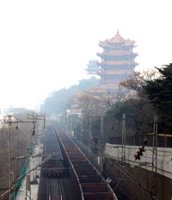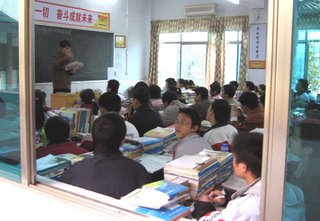
昔人已乘黃鶴去,此地空餘黃鶴樓。黃鶴一去不復返,白雲千載空悠悠。
晴川歷歷漢陽樹,芳草萋萋鸚鵡洲。日暮鄉關何處是?煙波江上使人愁。

昔人已乘黃鶴去,此地空餘黃鶴樓。黃鶴一去不復返,白雲千載空悠悠。
晴川歷歷漢陽樹,芳草萋萋鸚鵡洲。日暮鄉關何處是?煙波江上使人愁。


There is actually a major bridge linking the two sides right at the middle of the city. The
 This is an aerial view of a village near
This is an aerial view of a village near However, those
 This is “the” computer laboratory in a major YangXin high school. It contains 30 personal computers, in a high school of 5,000 students. If the laboratory is utilized all day, for seven days a week, each student can use the laboratory on average for about one minute per week. Because they are children of poor farmers, most have no computers at home. And the school forbids them to visit Internet cafes.
This is “the” computer laboratory in a major YangXin high school. It contains 30 personal computers, in a high school of 5,000 students. If the laboratory is utilized all day, for seven days a week, each student can use the laboratory on average for about one minute per week. Because they are children of poor farmers, most have no computers at home. And the school forbids them to visit Internet cafes.So computer lessons are learned mostly conceptually, with very little opportunities for practice. That partly explains why Chinese students are much stronger in conceptual and mathematical skills, but much weaker in practical, experimental skills. In this information-saturated age, this is a huge handicap.
This is collaborated by our experience with students from mainland
 This is one of the classes in a major high school in
This is one of the classes in a major high school in That’s why these students start school at 7 am and finish at 10 pm for six and a half days, with only Sunday afternoon off. Most of them live in and around the school because they come from a long distance. YangXin is a county of a million farmers, and this is one of the best high schools around. So competition to get into this school is keen, and the competition to get into good national universities is even keener. We can see their books all piled up on their desks, because they practically live in the classroom, leaving only to eat and sleep. We were told they regularly outperform their counterparts in schools in larger cities.
